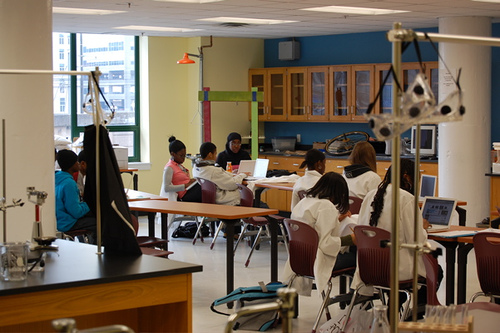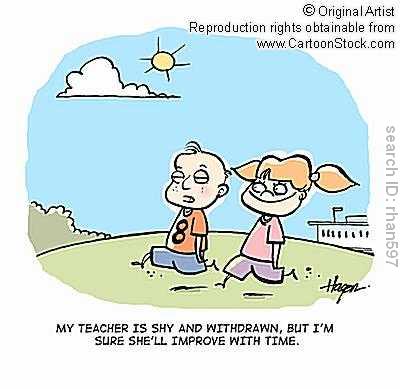Science teacher Robert Baxter was awarded $25,000 for excellence in the classroom in Buffalo, New York. As a black male, he says he was driven to succeed because no one expected him to be smart. After watching too many of his friends struggle with math and science, two of Baxter’s favorite subjects in school, he was determined to prove anyone can excel and anyone can learn. At Westminster, 98% of the students are minorities, and most come from poverty. Recently, 9 out of 10 eighth-graders who took Baxter’s science class had high enough grades to get high school biology credit.
PLAY TIME WITH KIDS
When I was young,  I was blessed to grow up on four acres of random desert in Tucson, Arizona. My Mom would have us go outside after breakfast and at 5:00 she would ring an enormous bell and we knew that we had fifteen minutes to make our way back to the house to get cleaned up for dinner. During the day, we would spend hours hunting for materials with which to build forts in the desert. We would also play in an old log cabin and sometimes in my Mom’s old 1956 car which sat in our driveway unused.  We would spend hours observing lizards, hoping to find snakes and chasing quail and roadrunners. Little did I know that the ingenuity the five of us had in these endeavors with our friends would be the foundation of our lives—personally and professionally. Time away from school in the great outdoors, parks or places of recreation are invaluable assets to developing healthy, creative, capable and strong-minded thinkers.
Today, as the article below indicates, many kids are programmed with little time to spend outside alone or with their friends exploring and creating. When kids have to think of things themselves—instead of having all decisions made for them—they learn to see choices, trade-offs and consequences. These critical thinking skills are crucial to success in college, career and life. The experience that students get while recreating not only helps many students burn-off excess energy, it helps them to develop a healthy, holistic outlook to life. In LifeBound’s books, we emphasize academic, emotional and social development and we don’t think one is better than the others. They are all needed for life success.
Article: Play time: Kids need invaluable, old-style, free-form fun
All work and no play makes very dull kids, and a tight schedule of organized activities — soccer, art classes, music lessons — is no help.
Read the full article at: denverpost.com
US schools need to look to top talent for effective teaching
In other countries around the world and in some of the best school systems that exist, 100 percent of teachers are in the top third of their graduating class from college. In the U.S. only 23 percent come from the top third and 14 percent of that number teach in our most needy, low-come and often urban schools.
First, to attract and retain the best minds to teaching, we have to esteem teaching and let more top talent from other fields into teaching. The George W. Bush Institute is opening a model of hiring experienced principals who have proven themselves as leaders in other realms of life. There are models for teaching that are similar to this, but the barriers to entry remain steep.  Second, we need to revamp the schools of education to be places where the brightest minds can grow, contribute, and thrive so that our teachers come out of college with the thinking and problem-solving skills to motivate and inspire the most disengaged students while keeping the brightest challenged to the fullest. Third, we need to strengthen the ability of all teachers to see their job and their world in increasingly broad terms so that they are bringing in current events, world challenges and other meaningful applications to their classes every day.
There are some amazing teachers who are in our classrooms. To recruit more  talented and bright minds of all ages, into teaching over the arc of their careers, we need students to see the best teachers in front of them every day facilitating, asking-questions, maintaining strong participation and providing courageous feedback for growth.
Article: Attracting and retaining top talent in US teaching
Helping teachers to lift student achievement more effectively has become a major theme in US education. Most efforts that are now in their early stages or being planned focus either on building the skills of teachers already in the classroom or on retaining the best and dismissing the least effective performers. The question of who should actually teach and how the nation’s schools might attract more young people from the top tier of college graduates, as part of a systematic effort to improve teaching in the United States, has received comparatively little attention.
Read the full article at: mckinseyquarterly.com
Bill Allows Students to Give Teacher Feedback
Carol’s Summary
Gov. Arnold Schwarzenegger wanted to go further in evaluating teachers and California student governments helped him attain his dream by creating a survey to give student feedback directly to their teachers in order to increase teacher effectiveness, which will be enforced by the bill Schwarzenegger recently signed. This bill hopes to incorporate student feedback into teaching methods and curriculum by letting students have an opinion on who teaches them and how they do it. The surveys will only be shown to the teacher of the class and not be accessible to administrators or be saved in the teacher’s personnel files.
Article: Students to get a voice on teacher performance under new state law
High school students will get a chance to say what they think of their teachers under a bill signed by Gov. Arnold Schwarzenegger.
To read this article: latimes.com
How Should Schools Identify Gifted Students?
Carol’s Summary:
Critics say that the test gives certain students an unfair advantage, whereas many others who come from less fortunate backgrounds may not be as well-prepared to take such a test. The cost of prep materials and tutoring gives wealthy students a good chance at being accepted, while students who come from less fortunate families may not be able to pay for the preparation.
Therefore, they may not be as well-prepared to take such a test. They say that the admissions tests should utilize several kinds of evaluations, including portfolios of students’ past work, essays, and interviews.
There are currently 3 million students nationwide who are identified as gifted, and it is believed that there are many more who have not yet been noticed or who have undergone one-sided tests such as the one previously mentioned. It is necessary to employ various strategies to identify gifted students, so that they may receive the education they deserve.
To hold back a student who is gifted may make the student likelier to grow bored with school and possibly even drop out, because their abilities are not being recognized. At LifeBound, we believe it is incredibly important to tailor teaching to individual students, their abilities and their needs. In our curriculum that accompanies each of our books, we have included activities for both gifted and at-risk students, so that no child’s needs are left unattended to. Visit www.lifebound.com or e-mail contact@lifebound.com for more information about our books and curriculum.
Article:
Identifying Gifted Students
By Walt Gardner
The latest chapter in the gifted student saga was on display at Hunter College High School in New York City when a graduating senior delivered a commencement address that called into question the basis for admission to the storied school (“Diversity Debate Convulses Elite High School,” Aug. 5). The school uses a single, teacher-written test that has not changed for decades. Although the test is defended by Hunter College, which oversees the high school, as “very valuable in terms of preserving the kind of specialness and uniqueness that the school has,” it has resulted in a decline in the percentage of black and Hispanic students enrolled.
To read the full article: www.edweek.org
How Will Eliminating D’s from School Records Affect Students?
Carol’s Summary:
The Mount Olive school district in New Jersey has recently eliminated the D grade from their schools, in order to encourage students to achieve more. Now that students can only earn A’s, B’s, C’s and F’s, it may cause students to see how important it is to get better grades, rather than to put forth minimal effort and earn a barely-passing D in their classes.
Students in the district have openly expressed their disdain for the new policy, saying that it puts more pressure on students and will cause more students to fail. The new policy will allow increased opportunities for make-up work on failed or missed assignments, which will provide students with a better chance to improve their grades before report cards are sent home.
The elimination of the D grade in Mount Olive schools has brought attention to this new policy, but a similar strategy was used in the 90’s in a college classroom in Kansas. The policy is new in the Mount Olive district for this upcoming school year, and administrators hope that it will be effective for improving student work ethic and achievement.
Many students need an extra push to understand that they are truly in control of earning their grades. The work they put forth academically as well as in all aspects of life will appear in the results of their work. Students, especially at high school age, must learn how to take personal responsibility for their study habits and school work.
Our book, Study Skills for High School Students, provides students with tips for improving memory, being more involved in their class work, how to be an independent learner, and how not to procrastinate on assignments. Visit www.lifebound.com or e-mail contact@lifebound.com for more about LifeBound’s books and materials.
Article:
Little as They Try, Students Can’t Get a D Here
Michael Appleton for The New York Times
MOUNT OLIVE, N.J. — Who wants to pay for “Dâ€-quality plumbing? Fly the skies with a “Dâ€-rated pilot? Settle for a “D†restaurant?
Exactly.
The way the Mount Olive school district sees it, its students should not be getting by with D’s on their report cards, either. This fall, there will no longer be any D’s, only A’s, B’s, C’s and F’s.
To read the full article: www.nytimes.com
President Obama Signs Emergency Bill to Halt Teacher Layoffs
Last Tuesday, the House proposed a $26 billion bill to preserve the jobs of 300,000 people, including teachers and police officers; the President signed the bill right away during the one-day session with lawmakers around the nation.
Is the Internet to Blame for Student Plagiarism?
Carol’s Summary:
Several colleges and universities nationwide are dealing with an increase of problems associated with plagiarism—the act of using information without giving credit to the source, largely due to students’ use of the internet while doing research for essays. Students at schools like DePaul and the University of Maryland have recently been caught plagiarizing, after their professors noticed that their text was copied verbatim for websites like Wikipedia.
A professor at Rutgers University found that 40 percent of 14,000 undergraduate students surveyed from 2006 to 2010 admitted to copying a few sentences from sources when writing essays for school. Only about 29 percent students today feel that taking information from the internet is a serious offense and should be considered “serious cheatingâ€. Some professors believe that plagiarism inhibits student’s creativity and writing skills.
In education, plagiarism is a serious offense, and students who are caught “stealing†information usually have to take a failing grade for the classes in which they plagiarized, and some may even be suspended from school altogether. Although it may be a tedious process, professors must be more aware than ever of plagiarism. Many colleges nationwide utilize computer software that tracks plagiarism attempts from students when they turn in their essays.
Our book, Study Skills for High School Students, talks about plagiarism and how serious of an offense it is. Plagiarism not only robs the original source of the credit they deserve but also takes creativity and credibility away from the student who plagiarizes. For more information about Study Skills for High School Students and other LifeBound books, visit www.lifebound.com.
Article:
Plagiarism Lines Blur for Students in Digital Age
By TRIP GABRIEL
At DePaul University, the tip-off to one student’s copying was the purple shade of several paragraphs he had lifted from the Web; when confronted by a writing tutor his professor had sent him to, he was not defensive — he just wanted to know how to change purple text to black.
To read the full article: www.nytimes.com
Why Has Closing the Achievement Gap Been Stagnant?
Carol’s Summary:
A report by the Education Testing Service shows that the achievement gap between black and white students, and efforts to narrow the gap have been stagnant for 20 years. The Educational Testing Service has examined the achievement gap and efforts to close it since 1910.
Some experts have developed a theory that standardized testing alone cannot account for the results of the study, and that social and environmental factors must also be taken into account. In order to close the achievement gap any further, it may be necessary to break the cycle of poverty first. However, the cycle of poverty is not only a result of the achievement gap, but also one of its main causes.
In order to further narrow the achievement gap, it will be necessary to provide equal opportunities for academic growth. Textbooks in poverty-stricken areas would need to be of the same quantity and quality as books for children in middle-class areas. Standardized testing results will have to take into account more than the scores alone but also the advantages and disadvantages, and individual needs of the schools and students.
Teachers who work in schools in impoverished areas will also need to be trained in such a way that they can identify and connect better with their students and the issues that students face both in and out of the classroom. LifeBound visits with teachers from schools in both middle-class areas and areas where people are disadvantaged, and we coach them with our books and curriculum so they can collaborate and work with all students, regardless of their background. To learn more, visit www.lifebound.com or e-mail contact@lifebound.com
Report: When/why progress in closing achievement gap stalled
Progress seen over several decades in narrowing the educational achievement gap between black and white students has remained stalled for 20 years, according to data analyzed in a new report.
Called “The Black-White Achievement Gap: When Progress Stopped,†the report by the Educational Testing Service examines periods of progress and stagnation since 1910 in closing the achievement gap.
To read the full article: www.washingtonpost.com
Many States Adopt National Standards for Their Schools
Carol’s Summary:
Twenty-seven states have adopted a nationwide standardized curriculum that was proposed around two months ago by the Department of Education, partially due to the Race to the Top competition, which will award billions of dollars in funding to states with plans to implement education reform.
Massachusetts, New York, and Colorado are among the states that will adopt the new set of curriculum. The standards contain a detailed description of what students at each grade level will be expected to learn and comprehend, and what academic skills they should have at each level. However, the process of implementing the new national standards is estimated to take years to complete.
Education reform and the implementation of national standards is predicted to save states money in the long run, as states will no longer have to make their own individual curriculum standards. Some educators are also worried that the cost of re-training teachers may be more trouble than it’s worth initially. When LifeBound has coaching sessions, we do so with the goal of showing teachers how to communicate and connect with students effectively and in a way that allows for long-term success. Training teachers is a highly effective way of ensuring future success with students.
As society continues to change, the education system must catch up and be restructured as well. The way that children learned fifty years ago is much different from how they learn now, and it will take possibly years of trial and error to fully restructure the education system as it has been proposed. What’s most important is that education fosters the goals and needs of all children, and of the whole child, not just academically speaking.
Article:
Many States Adopt National Standards for Their Schools
By TAMAR LEWIN
Published: July 21, 2010
Less than two months after the nation’s governors and state school chiefs released their final recommendations for national education standards, 27 states have adopted them and about a dozen more are expected to do so in the next two weeks.
To read the full article: www.nytimes.com













